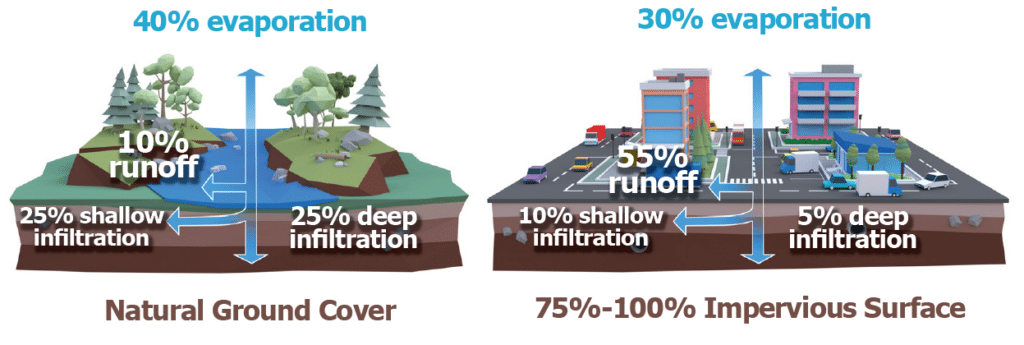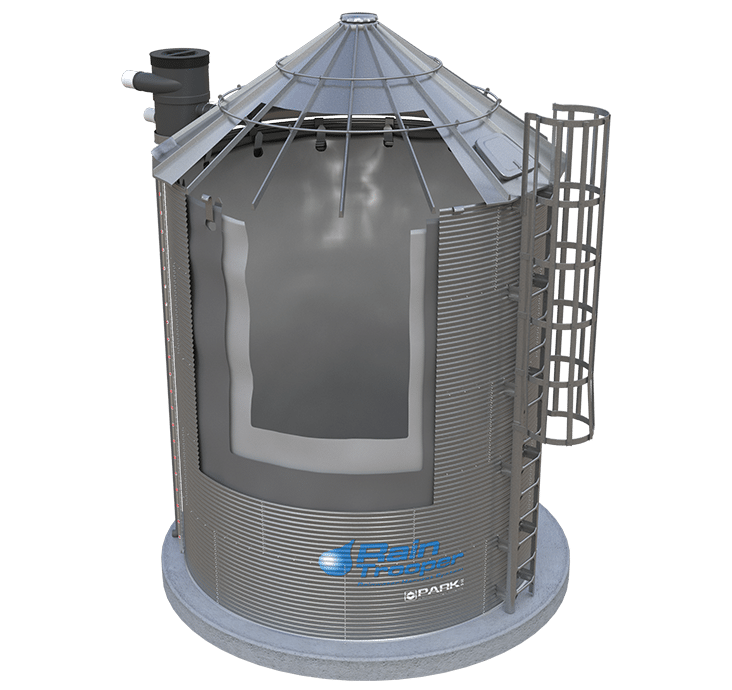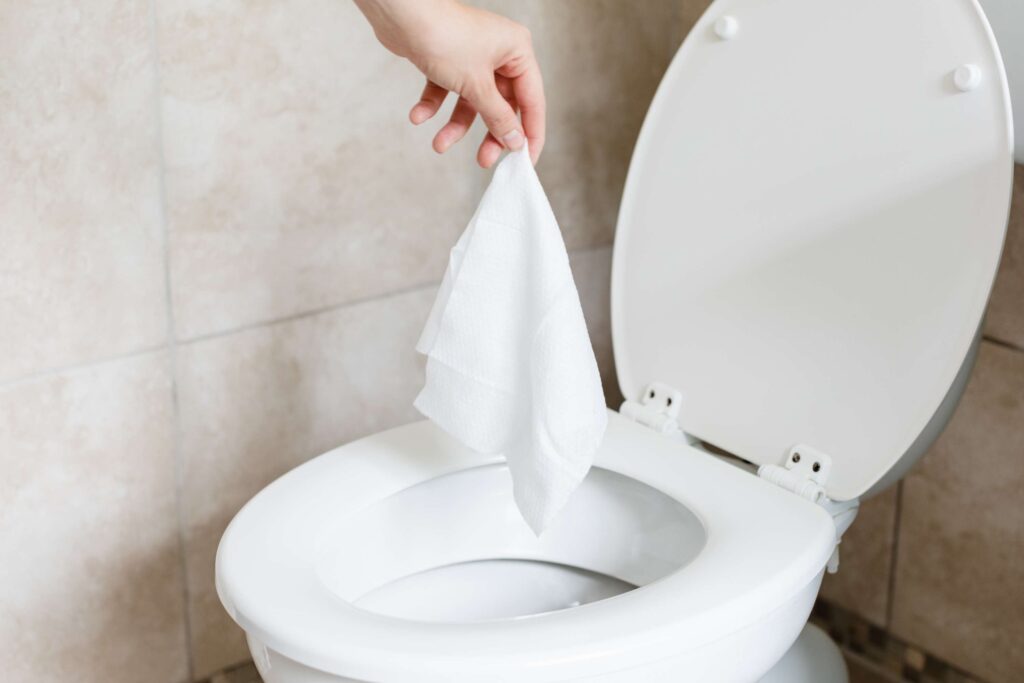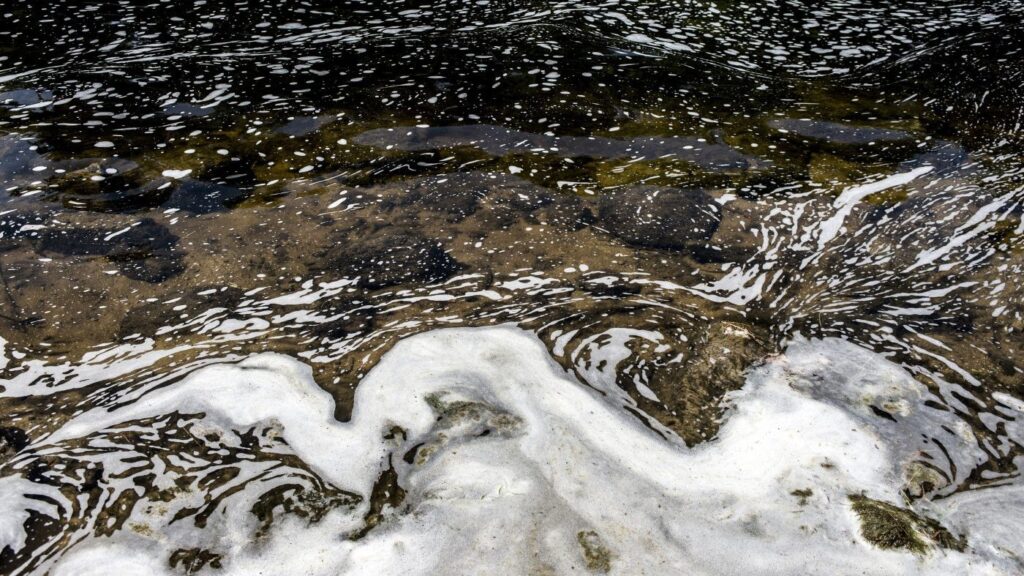Background
The traditional approach to stormwater is to move the water as fast as possible away from businesses and homes. Different means of conveyance include underground systems, concrete lined channels, and open ditching. During a heavy rain event, when the underground infrastructure is at full capacity, roadways often become a secondary form of conveyance. This method of moving stormwater transports terrestrial pollutants into receiving streams, lakes, oceans and other water bodies as well as increased flows and velocities in those water bodies; impacting the water quality and quantity downstream.
Problem
Development within a watershed often results in increased impervious cover which in turn changes the water budget. The increase in volume and rate of runoff from a site as well as the reduction in ground water recharge is directly related to the increase in impervious surface within the watershed. The increased runoff contributes to downstream flooding and reduced groundwater recharge.
Solution
One management strategy that focuses on maintaining pre-development hydrology is low impact development (LID) which includes integrated management practices known as green infrastructure (GI). LID/GI techniques focus on keeping the runoff close to its source and mimicking pre-development hydrology by using infiltration; filtering; storage; evaporation; and detention. The philosophy is to keep the water safely on-site as long as possible, use small distributed features located on-site to mitigate and treat runoff and take advantage of nature. Increased roughness, infiltration, soil modification and on-site storage are LID methods.
Increase in roughness can be accomplished by minimizing impervious cover, disconnecting impervious services, forcing water to pass over vegetated areas, allowing impervious surfaces to drain into natural areas and planting grasses or vegetation in swales to slow velocities. Increase in infiltration and/or on-site storage can be accomplished by the use of pervious paving, native vegetation, green roofs, rain gardens, bioswales, vegetated filter strips, on-site detention and manufactured treatment devices.
LID is supported through federal, state and municipal regulations. For example, the Energy Independence and Security Act of 2007 requires federal development projects with a foot print exceeding 5,000 square feet to maintain or restore the pre-development hydrology of the property. Federal agencies such as the Environmental Protection Agency, Department of Defense, United States General Services, Department of Housing and Urban Development, Federal Emergency Management Agency and the Natural Resources Conservation Service of the Department of Agriculture promote and utilize LID.
An example of a municipality embracing LID is the fact that the City of Los Angeles, California has adopted an ordinance imposing rainwater LID strategies on projects that require building permits. The City requires stormwater runoff to be infiltrated, evapotranspired, captured and used, and treated onsite without allowing any runoff leaving the site for a specified design storm event. States and cities nationwide are adopting LID as an option for managing stormwater runoff. Maryland is one of the first states to implement LID. One Maryland project, Somerset Rain Gardens, realized a significant savings when rain gardens were utilized instead of conventional ponds: $100,000 compared to $400,000 respectively.
PaskUSA possesses several product lines that are great BMP options for LID projects. Below is a listing of some of our products.
Rainwater
ParkUSA®’s RainTrooper® is a solution for commercial and residential applications to conserve as much rain as possible to store for future use and to reduce consumption of the limited treated municipal water meeting LID design goals. The RainTrooper is designed with the following components: catchment devices, debris filtration, flush diverters, water storage tanks, pump systems, and water disinfection systems.
The ParkUSA® RainFilter™ is a complete system designed to treat total suspended solids (TSS), debris, and trash from stormwater runoff. It presents a low footprint, consists of a high-density polyethylene (HDPE) tank, an internal stainless-steel filter, and an optimal storage system.
The ParkUSA RainBasin® is a stormwater detention system designed to mitigate the effects of new development and redevelopment on an existing drainage system. In addition, the system can be used for the management of storable and reusable stormwater runoff through ground water recharge or rain harvesting. The RainBasin is a system that affords the designer the opportunity to maximize the developed land by placing the detention easily underground such as under parking lots and roadways with minimal cover, as well as being a LID technique.
Floatables
The ParkUSA® FilterBasin™ is a family of stormwater best management practice (BMP) devices designed to fit within common basin structures to provide an economical BMP solution. These basins present an opportunity to pre-filter the stormwater prior to discharging into rain gardens and storm sewers.
Biofiltration
The TreeBasin™ is a biofiltration BMP that can be used in LID applications like stand-alone treatment, pretreatment for infiltration, rainwater harvesting, and detention. The TreeBasin system uses a combination of physical, chemical, and biological processes to remove nutrients, sediments, hydrocarbons, metals, and trash from stormwater. The TreeBasin uses an engineered filtration/absorbing media which presents the ideal characteristics to grow a tree. TreeBasins are highly adaptable for most developments due to a small footprint and shallow elevation. Plant selection allows TreeBasins to be seamlessly integrated into the landscape and adds aesthetic value. Typical TreeBasin applications include parking lots, sidewalks, plazas, and streets.
The NutriBasin™ is a filtration device designed to remove dissolved nutrients (e.g. phosphorus and nitrogen) from stormwater runoff with high removal rates for phosphorous (above 90% removal). It consists of a concrete vault with top access hatchway; inlet and outlet pipe connections; and an engineered biofiltration media contained in removable cartridges. The NutriBasin™ design allows for easy maintenance. All servicing can be done without entering the vault, which avoids confined space hazards.
The MarshBasin™ is a wetland treatment BMP: an engineered ecosystem that emulates the natural wetland’s ability to improve water quality and is a LID technique. The MarshBasin can be used in stand-alone applications, pretreatment for infiltration, rainwater harvesting, and detention applications. It uses a combination of physical, chemical, and biological processes to remove nutrients, sediments, hydrocarbons, metals, and trash. The MarshBasin design allows for use from small urban areas to highly developed cities.The MarshBasin is highly adaptable for most developments due to its small footprint and shallow elevation. Typical applications include parking lots, sidewalks, plazas, and streets.







